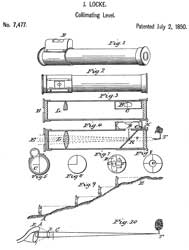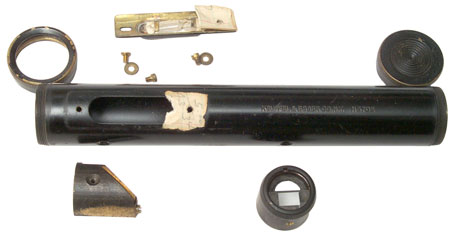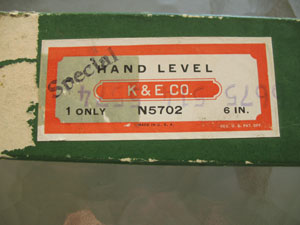 |
7477
Collimating Level, John Locke (Parbook),
1850-07-02, - The image of the cross wire/bubble are collimated so that they appear at infinity. This allows the observers eye to focus on both at the same time. |
John Locke, in U.S. patent 7477 (7477 at Google Patents) dated July 2, 1850 , describes the basic design for the hand level. The target is sighted directly with no optics. A lens in the form a 1/2 circle is used to collimate the bubble. After this patent expired many "Locke" hand levels were made.
7477 Collimating Level, John Locke (Parbook), 1850-07-02, -
The image of the cross wire/bubble are collimated so that they appear at infinity.
This allows the observers eye to focus on both at the same time.

This is an image aligned at 45 degrees of the center reflector. The right hand portion with the 45 degree bevel toward the eye end (at the very left) has a silvered surface at the center that acts as a mirror to allow viewing the bubble from below at the center line.
Looking back into the front right hand part there is a horizontal metal vane that acts as a cross line to mark the target. There are no optics, other than the first surface mirror. The eye hole has threads (Why?) with an I.D. of 0.168".
The purpose of the 0.168 thread may be to allow the installation of a peep hole eyepiece.
This peephole is on a K&E hand level marked with the patent date of 24 Apr 1894.
518678 Hand Level, J. Paloi, Apr 24, 1894, 356/249 - probably sold to K&E.
If you know anything about this level email brooke(at)pacific(dot)net.Operation
As far as I can tell there are no lenses in this instrument. If I wear my reading glasses I can see the bubble, although out of focus, and can accurately center it vertically on the horizontal reference line formed by the sheet metal vane at the front of the instrument, but the far objects are blurry. If I don't wear my reading glasses there is a bright spot where the bubble is located, but the horizontal cross line is about invisible.Moving the front piece back and forth will allow the largest bubble image to be centered on the horizontal line and does not change the level line.
 After the
Locke patent expired K&E started making their version.
That's why there is no patent info on it.
After the
Locke patent expired K&E started making their version.
That's why there is no patent info on it.
This level is not marked N5702, but I think that is the
pattern. Just marked Keuffel & Esser Co. N.Y.
Note that the front "glass" is not a lens, just a glass to keep
the inside clean. Also there is a rear "glass". There
is a 1/2 circle lens about 2 1/2 inches from the eye hole that
allows your eye to focus on the bubble when it is also focused at
infinity to see the target. It's not clear how the sight
line is calibrated to be level.
This is very similar to the hand level used by my Uncle, Charles Carrithers, to check lath stakes when leveling land. In addition to the level he had a lath on the tractor with a notch, maybe 3 feet up from one end. The laths driven into the ground by the surveyor had a horizontal mark 3 feet above the desired grade. So if he saw the mark from the ground where he was sighting then the grade was correct. If not he would know how much to cut or fill.
There are other Locke pattern hand levels made by K&E that
have the model number N5702 or N5703, I'm not sure of what
differences there are between these.

At the lower left is a half cylinder with a first surface mirror
held on by a screw. This assembly is held in the tube
by a single flat head screw (the hole in the tube is just above
it).
At the lower right is the half lens. The upper part has no
glass. The square part below has a lens to allow an eye
focused at infinity to also focus on the bubble.
Someone has use a few pieces of 3x5 card to shim the rear end of
the level vial.
The level vial has a single fiducial mark at the center, not the
two marks as are common on builder's levels. This way the
view through the tube is the bubble vial on the left with the
central mark acting as cross hairs.

Note that an Abney (Wiki)
hand level is also called a clinometer. It is different than
the Locke hand level in that it has a vertical scale to measure
the inclination of the instrument.
If you know the patent number (UK or US or ?) please let me know.
The design of the Abney has the back of the scale covered by the frame that holds it. There was a requirement to have two different scales. If they were both on the same part (side by side) the operator often read the wrong scale, so two scales were supplied and the inclinometer needed to be disassembled and reassembled to change scales.
1125053
Surveying Instrument, H. Brautigam, Jan 19 1915, - describes the
Abney then adds a hole in the side of the tube to make a 90 degree
sight.
2137776
Hand Level, M. Leupold, Nov 2 1938, - quick change Clinometer
scale plates with unused plate stored on level
2285285
Clinometer, W.L.E. Keuffel (K&E), Jun 2 1942, - has a movable
index that blocks the unused scale from view.
648380
Surveying Instrument, J.A. Bersfield, May 1 1900 - mentions the
Abney Level
There seem to be a number of different K&E hand levels:
The square tube versions allow resting the level on a bench or other support without it rolling. Also some of the square tube versions have the 90 sighting feature.
Kuker
Marked: PAT 1741422, KUKER-RANKEN INC, SEATTLE
1741422 Hand Level Dec 21, 1929 O. J. Kuker 356/249 - provision for adjustment
Weber
"Weber Phila No 6160" is a 5" long when collapsed and 5 1/2" long extended hand level with a 13/16" diameter round tube.
Back to Brooke's Products for Sale,
Astronomy, Navigation
Orientation
& Position, Sundials, Surveying, Time
&
Frequency, Military Information,
Home page
Page created 4 Feb 2003.